
|
 |
 |
by Liesl Clark April 23, 1999 March 23, 1999: Zhang-Mu, Tibet A thick brown pall hangs in the air, as the wind picks up the dust from Zhang-Mu's streets. We're on the border between Nepal and Tibet, a no man's land presided over by Chinese customs officials and immigration officers in smart black and green suits. Local Tibetans swarm around us as we stuff our stamped passports into our backpacks. "Change money?" they ask, knowing we'll have to change our Nepalese rupees into Yuan, the standard Chinese currency. Now that the entire team has made it across the border, little can stop us from reaching our destination: Everest Base Camp at 17,000 feet. Only landslides, avalanches, altitude sickness, or vehicle breakdowns on the road could slow us from getting there within the week, explains Eric Simonson, our expedition leader. Unlike Everest on the south side, from the north we can literally drive up to the mountain's base. It will take at least five days to adjust our bodies to the increasing altitude as we approach camp.
March 25: Zhang-Mu to Nyelam As we leave Zhang-Mu, our driver stops the bus and honks, unwilling to move forward. It's obvious something is in the street, as people watch from their doors to see what the driver will do. He finally gets out of the bus to shoo away the culprits: four pigeons oblivious to the noise, pecking at something in the road. "It's a good sign," says Hoyland. He knows that the drive ahead warrants thoughtful driving. Soon the left side of the road drops thousands of feet down to the gorge of the Bhote Kosi river below. Simonson comments that this is a heavy fault region, the tectonic plates of the Tibetan Plateau and the Indian subcontinent butting heads beneath us. Mud gives way to snow and we climb up and out of the deeply cut valley toward the craggy Himalayan peaks that beckon in the distance. It's clear we're finally in the mountains.
In the morning after breakfast, we all head up into the hills to get some exercise and a 2,000-foot gain in altitude. The snow begins to blow hard and oddly we welcome it, knowing this is the first step in the 'hardening' process that one has to go through to endure Everest. Some team members joke about how quickly one forgets the misery and cold of high places. But now that we're here, we all know what drives us back to the mountains—the challenge, the beauty, and the self-discovery. Several burning questions linger in particular: Will we find any evidence of Mallory or Irvine on the mountain? Is it possible that we might find some clues as to what happened to them on their fateful summit day in June of 1924? March 27: Nyelam - Tingri Driving further east, the brown hills and open expanses of Tibet take shape. We pass by small Tibetan villages with the ruins of monasteries standing in silent testimony to the Cultural Revolution. Brown fields are being cultivated for potatoes and barley. It's hard to imagine anything can grow in this parched cold climate. As we climb up toward the Son La Pass, the top of the watershed, we're finally on the Tibetan Plateau: Brown hills in the distance take shape in the cold, dusty wind. You have to carefully choose in which direction you gaze, avoiding the biting gusts that sting eyes and ears.
March 29: Tingri - Base Camp After two days of acclimatizing in Tingri, we're sufficiently anxious to get to Base Camp. Being on the move has been good for us to adjust to the rhythms of the weather. Days are windy and cold, and evenings are the time to be deep within your sleeping bag, staying warm in the still night air. We leave early in the morning for the last leg of our journey, a six-hour drive up over the Pang La pass to Base Camp. Views on the pass are breathtaking, with Everest and Cho Oyu demanding attention. It's all finally coming together. After months of preparation for the trip, Everest stands before us and the air is still. There is no plume cloud streaming from the summit, not a cloud in sight, or a single puff of wind. Today would be a good summit day.
Unanswered Questions (May 25, 1999) Forty-Eight Yaks (May 21, 1999) On Top of the World (May 17, 1999) Summit Team Moves Higher (May 16, 1999) Still at Camp V (May 15, 1999) Snow Bound (May 14, 1999) Outsmarting the Weather (May 13, 1999) Last Trip Up (May 12, 1999) Up to ABC/The Rescue (May 11, 1999) The Image of Mallory (May 8, 1999) In Extremis (May 7, 1999) Pieces of the Puzzle (May 6, 1999) Dearest George (May 5, 1999) Mallory's Discoverers Return (May 4, 1999) Mallory Reported Found (May 3, 1999) Waiting in Silence (May 1, 1999) Up to the Search Site (April 30, 1999) To the North Col (April 29, 1999) Waiting out the Wind (April 28, 1999) Search About to Begin (April 25, 1999) Pitching a 1933 Tent (April 23, 1999) Early Camp Found at 21,750 Feet on Everest (April 20, 1999) Up to Base Camp (April 23, 1999) Photos: Liesl Clark Lost on Everest | High Exposure | Climb | History & Culture | Earth, Wind, & Ice E-mail | Previous Expeditions | Resources | Site Map | Everest Home Editor's Picks | Previous Sites | Join Us/E-mail | TV/Web Schedule About NOVA | Teachers | Site Map | Shop | Jobs | Search | To print PBS Online | NOVA Online | WGBH © | Updated November 2000 |
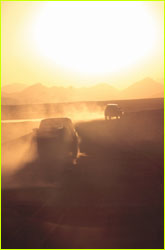 Vehicles now take the place of yaks on the high flat
plateau.
Vehicles now take the place of yaks on the high flat
plateau.
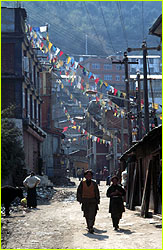 The border town of Zhang-Mu is the major spot to find
provisions.
The border town of Zhang-Mu is the major spot to find
provisions.
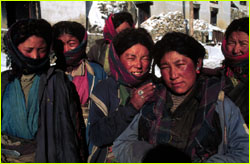 A crowd of Tibetan women eye the LCD screen of the
digital camera with interest.
A crowd of Tibetan women eye the LCD screen of the
digital camera with interest.
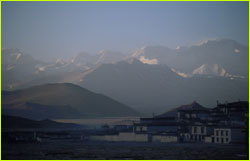 The dusty town of Tingri is one of the last stops en
route to Base Camp.
The dusty town of Tingri is one of the last stops en
route to Base Camp.
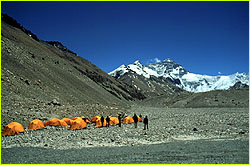 The North Side Base Camp sits on a terminal moraine;
Everest looms behind.
The North Side Base Camp sits on a terminal moraine;
Everest looms behind.